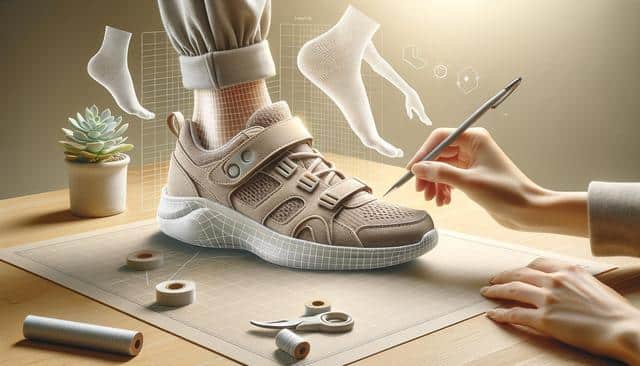
Why Orthopaedic Shoes Are a Smart Step Toward Comfort and Support
Understanding What Makes Orthopaedic Shoes Different
Orthopaedic shoes are designed with the goal of improving foot function while reducing discomfort associated with standing or walking for long periods. Unlike regular footwear, these shoes are specifically made to cater to the anatomical and structural needs of the feet. They often include features such as cushioned insoles, arch support, and wide toe boxes, all of which contribute to better alignment and stability. These elements are particularly helpful for individuals who suffer from conditions such as plantar fasciitis, bunions, arthritis, or flat feet.
What sets orthopaedic shoes apart is the attention to ergonomics and motion control. Their construction supports proper gait, helping to reduce strain not just on the feet, but also on the knees, hips, and lower back. In many cases, wearing orthopaedic shoes can reduce the likelihood of injury and alleviate chronic pain associated with inadequate footwear.
- Enhanced arch support
- Shock-absorbing soles
- Removable insoles for custom orthotics
- Adjustable closures for a tailored fit
These features make orthopaedic shoes a practical choice not only for those with existing foot conditions but also for those looking to prevent future issues.
Who Can Benefit from Orthopaedic Footwear?
Orthopaedic shoes are not just for older adults or those recovering from surgery. They are increasingly being recognized as a valuable option for a wide range of individuals. Office workers who spend hours on their feet, delivery drivers walking long distances, teachers, healthcare workers, and even athletes during recovery phases can benefit greatly from the comfort and support these shoes provide.
People with the following conditions often find relief with orthopaedic footwear:
- Diabetes-related foot issues
- Heel spurs and plantar fasciitis
- Overpronation or supination
- Postural imbalances and leg length discrepancies
Children and teenagers undergoing physical development can also benefit from orthopaedic shoes, especially if they exhibit signs of flat feet or abnormal walking patterns. In these cases, early intervention with supportive footwear can promote healthier posture and alignment.
Key Features to Look for in Orthopaedic Shoes
When considering orthopaedic shoes, it’s important to know what to look for to ensure you’re selecting a pair that will truly support your needs. The right pair should feel comfortable from the first wear and not require a long break-in period. Pay attention to the following features:
- Contoured footbeds that align with the natural curve of the foot
- Deep heel cups that enhance stability
- Non-slip soles for improved safety
- Soft yet firm midsoles for shock absorption
Material choice also plays a role. High-quality leather or breathable mesh can increase comfort and durability. Many orthopaedic shoes also offer moisture-wicking linings to keep feet dry and reduce the risk of fungal infections. The availability of wide sizes and half sizes helps ensure a proper fit, which is crucial for effectiveness.
For those who use custom orthotics, choosing shoes with removable insoles is a must. This allows users to insert their prescribed orthotic devices without compromising fit or function.
Style and Versatility in Today’s Orthopaedic Footwear
Gone are the days when orthopaedic shoes were only available in bulky or unattractive styles. Today’s market offers a wide variety of designs that blend function with fashion. This shift allows consumers to choose shoes that not only feel good but also look good, whether for work, casual outings, or formal events.
Modern orthopaedic shoes are available in various styles, including:
- Dress shoes with supportive soles
- Sporty sneakers with enhanced cushioning
- Sandals with contoured footbeds
- Winter boots with orthopedic features
Thanks to advancements in material and design technology, manufacturers are able to produce stylish options without compromising the structural benefits. This means users no longer have to choose between comfort and appearance—they can have both. As awareness of foot health grows, more people are seeking footwear that supports their lifestyle while also matching their personal style.
How to Choose the Right Pair for Your Needs
Selecting the right orthopaedic shoes starts with understanding your specific foot needs. A visit to a podiatrist or a foot specialist can help identify any underlying issues that require targeted support. Once you have a clear understanding, shopping becomes a more focused experience.
Here are a few tips to help you make the right choice:
- Try shoes on at the end of the day when your feet are at their largest
- Wear the type of socks you plan to use with the shoes
- Walk around in the store to assess comfort and support
- Check for pressure points or areas that feel tight
While price can be a consideration, think of orthopaedic shoes as an investment in your overall health. Choosing a well-made pair can reduce the risk of future foot problems and improve your daily quality of life. Many options now offer a balance between affordability and durability, making it easier to find shoes that meet your physical needs and your budget.
Conclusion: Investing in Your Comfort and Mobility
Orthopaedic shoes offer far more than basic foot coverage. For individuals dealing with discomfort, structural foot issues, or those who spend long hours on their feet, these shoes can make a noticeable difference in daily comfort and long-term health. With an array of styles and supportive features now available, orthopaedic shoes are becoming a practical and stylish choice for a broad audience. Prioritizing foot health means investing in mobility, posture, and overall wellness—one supportive step at a time.


